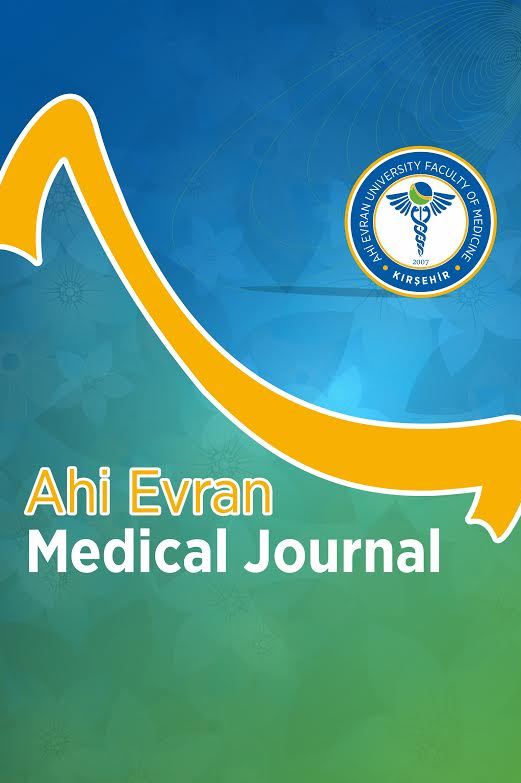Bell Palsi (İdiyopatik Fasiyal Paralizi) Rehabilitasyonunda Fizik Tedavi Seans Süresi Fonksiyonellik Üzerine Etkili Mi?
house brackmann evrelemesi, idiopatik fasiyal paralizi, sunny brook evrelemesi, rehabilitasyon süresi, yüz felci engellilik indeksi
Is Physical Therapy Session Duration Effective on Functionality in Rehabilitation of Bell's Palsy (Idiopathic Facial Paralysis)?
facial disability index, house brackmann system, idiopatic facial paralysisbell, sunny brook grading system, rehabilitation duration,
___
- 1. Peitersen E. Bell's palsy: the spontaneous course of 2,500 peripheral facial nerve palsies of different etiologies. Acta Otolaryngol Suppl. 2002(549):4-30.
- 2. Kafle DR, Thakur SK. Evaluation of prognostic factors in patients with Bell's palsy. Brain Behav. 2021;11(11):e2385.
- 3. Cappeli AJ, Nunes HRdC, Gameiro MdOO, Bazan R, Luvizutto GJ. Main prognostic factors and physical therapy modalities associated with functional recovery in patients with peripheral facial paralysis. Fisioter. Pesqui. 2020;27(2):180-187.
- 4. Yoo MC, Soh Y, Chon J, et al. Evaluation of Factors Associated With Favorable Outcomes in Adults With Bell Palsy. JAMA Otolaryngol Head Neck Surg. 2020;146(3):256-263.
- 5. Agostini F, Mangone M, Santilli V, et al. Idiopathic facial palsy: umbrella review of systematic reviews and meta-analyses. J Biol Regul Homeost Agents. 2020;34(4):1245-1255.
- 6. Tuncay F, Borman P, Taser B, Ünlü I, Samim E. Role of Electrical Stimulation Added to Conventional Therapy in Patients with Idio-pathic Facial (Bell) Palsy. Am J Phys Med Rehabil. 2015;94(3):222-228.
- 7. Jébéjian R. Treatment of peripheral facial paralysis with ultrasound. Ann Otolaryngol Chir Cervicofac. 1984;101(6):471-479.
- 8. Ordahan B, Karahan Ay. Role of low-level laser therapy added to facial expression exercises in patients with idiopathic facial (Bell’s) palsy. J Lasers Med Sci. 2017;32(4):931-936.
- 9. Di Stadio A, Gambacorta V, Ralli M, et al. Facial taping as biofeedback to improve the outcomes of physical rehab in Bell’s palsy: preliminary results of a randomized case–control study. Eur. Arch. Oto-Rhino-Laryngol. 2021;278(5):1693-1698.
- 10. Zhang R, Wu T, Wang R, Wang D, Liu Q. Compare the efficacy of acupuncture with drugs in the treatment of Bell's palsy: A systematic review and meta-analysis of RCTs. Medicine. 2019;98(19): e15566.
- 11. Teixeira LJ, Valbuza JS, Prado GF. Physical therapy for Bell's palsy (idiopathic facial paralysis). Cochrane Database Syst Rev. 2011(12):Cd006283.
- 12. Watson GJ, Glover S, Allen S, Irving RM. Outcome of facial physiotherapy in patients with prolonged idiopathic facial palsy. J Laryngol Otol. 2015;129(4): 348-352.
- 13. Kandakurti PK, Shanmugam S, Basha SA, et al. The effectiveness of low-level laser therapy combi-ned with facial expression exercises in patients with moderate-to-severe Bell's palsy: A study protocol for a randomised controlled trial. Int J Surg Protoc. 2020;24:39-44.
- 14. IBM Corp Ibm S. statistics for windows, version 25.0. Armonk, NY: IBM Corp. 2017.
- 15. Baricich A, Cabrio C, Paggio R, Cisari C, Aluffi P. Peripheral facial nerve palsy: how effective is rehabilitation? Otol Neurotol. 2012;33(7):1118-1126.
- 16. Pereira LM, Obara K, Dias JM, Menacho MO, Lavado EL, Cardoso JR. Facial exercise the-rapy for facial palsy: systematic review and meta-analysis. Clin Rehabil. 2011;25(7):649-658.
- Yayın Aralığı: Yılda 3 Sayı
- Başlangıç: 2017
- Yayıncı: Kırşehir Ahi Evran Üniversitesi
Hasan Gazi UYAR, Aysegül BAYIR, Hasan KARA, Pınar KARABAĞLI, Abdullah SİVRİKAYA, Ali UNLU
Recai DAĞLI, Ülgen ÇELTİK, Fatma ÇELİK, Zeynel Abidin ERBESLER, Zeynep KÖYLÜ
Burak TAN, Ercan BABUR, Umut BAKKALOĞLU, Ayşenur ÇİMEN, Cem SÜER, Meral AŞÇIOĞLU
Kronik Ürtiker Hastalarında Fibromiyalji Sendromu Sıklığının Değerlendirilmesi
COVID-19 Nüks, Reenfeksiyon Sıklığı ve Vakaların Klinik Özellikleri
Hümeyra ASLANER, Hacı Ahmet ASLANER, Yasemin SAVRANLAR, Ali Ramazan BENLİ
Doktorlarda Sigara Bağımlılığı: Anadolu’dan Kesitsel
Esra BALCIOĞLU, Münevver BARAN, Fazile CANTÜRK TAN, Tuba ÖZKUL, Arzu YAY, Menekşe ÜLGER, Betül YALÇIN, Demet BOLAT
Pandeminin İlk Aylarından Bir İnfodemi Deneyimi, Türkiye
Gülcan DEMİR, Cüneyt ÇALIŞKAN, Hilal ÖZCEBE
Funda EREN, Esra FIRAT OĞUZ, Salim NEŞELİOĞLU, Rıdvan FIRAT, Osman İNAN, Emin GEMCİOĞLU, Enes ŞAHİNER, İhsan ATEŞ, Özcan EREL
